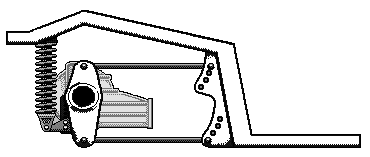4 Link Suspensions
The 4-link is a common suspension design that has been utilized, successfully,
in many different applications. Typically, the design includes 4 equal or unequal
length control arms, a lateral locating bar, springs, and shock absorbers.
One benefit of a 4-link is that, when the bars are of equal or near-equal
length, and the front and rear mounting points are oriented such that the bars
are parallel, there is a reasonably unrestricted range of vertical motion for
the axle, while maintaining an efficient coupling. In addition, because each
pair of links is independent of the other, the axle can "rotate" freely, allowing
for roll. In practical terms, this means that when one wheel has to travel in
a different vertical path than the other wheel (over a bump, up a driveway),
the unaffected wheel stays in contact with the ground. Or, imagine a turn: The
body rolls to the outside of the turn, decreasing the distance between the frame/body
and the outside axle end, and increasing the distance between the frame/body
and the inside axle end. The 4-link design, with its parallel links that pivot
at each end, is designed to resolve this relatively complex set of dynamic variables.
This basic design is found in many factory applications. GM cars, like Chevelles,
come to mind, as do late-model Corvettes. Of course, the design is very popular
in drag racing, on sprint cars, and on street rods.
 Side to side movement
is controlled by a Panhard rod or a track locator. A Panhard rod is mounted
laterally between the axle, at one end, and the frame at the other. A track
locator is mounted diagonally between the opposing front and rear pivot points
of the lower 4-link bars.
Side to side movement
is controlled by a Panhard rod or a track locator. A Panhard rod is mounted
laterally between the axle, at one end, and the frame at the other. A track
locator is mounted diagonally between the opposing front and rear pivot points
of the lower 4-link bars.
What about Ladder Bars?
From the perspective of a street-driven car, the basic problem is that the
ladder bar design does not resolve for axle rotation, except in the vertical
axis. Nothing against ladder bars, it's just that it's not an efficient method
of suspension attachment for street cars. In their intended environment, a doorslammer
drag car, ladder bars allow for a solid coupling and an easy determination of
instant center. But as a street suspension, ladder bars are woefully inadequate.
Visualize holding a door, like the front door of your house. In this visualization,
you will be acting as the forward ladder bar mount. Orient the door so that
you're holding the hinges; the door should be horizontal, held out away from
you, and swinging, up and down, on the hinges. Now, visualize a wheel, one at
each of the two outside corners opposite the hinges; the long edge of the door,
opposite you, will be the rear axle.
What we've done is to model a typical ladder bar suspension. To see how it
works, visualize the door swinging up and down. As long as the door is pivoting
on its hinges, with no rotational forces involved, everything works great. Now,
try moving the corners opposite you (The corners that we're calling "wheels")
in different directions...one corner up, one corner down. See what happens?
The door wants to rotate right out of your hands! This is precisely what happens
when you turn a corner, or go up a driveway, in a ladder bar equipped street
car. Ouch!
The design considerations necessary to resolve this problem include lengthening
the bar, moving the front ladder bar mounting points closer together (triangulating),
and using a large, soft bushing. Take a look underneath a mid-60's GM pickup
(or a Grand National stock car, for that matter...). Street rodders, look at
the Pete & Jakes ladder bar design. All use long, triangulated bars with big
bushings. The only ladder bar that even comes close is the Chassiswork's Pro
Street bar, which doesn't use a triangulated design, but does use a urethane
bushing.
What's the Bottom Line?
Obviously, ladder bars are very popular, likely because of the design's simplicity.
The 4-link design is more complex, often requiring some engineering and fabrication.
On the plus side, the 4-link is a superior method of axle control, especially
in street cars, offers infinite adjustablility, and is the only way to get your
hot rod really low. So...think about it first. Design your ride for safety and
longevity; don't use race car parts or designs in street cars unless you're
sure that they'll live.
 Side to side movement
is controlled by a Panhard rod or a track locator. A Panhard rod is mounted
laterally between the axle, at one end, and the frame at the other. A track
locator is mounted diagonally between the opposing front and rear pivot points
of the lower 4-link bars.
Side to side movement
is controlled by a Panhard rod or a track locator. A Panhard rod is mounted
laterally between the axle, at one end, and the frame at the other. A track
locator is mounted diagonally between the opposing front and rear pivot points
of the lower 4-link bars.